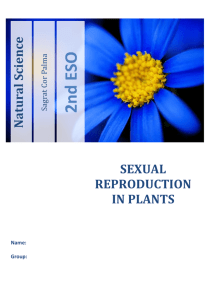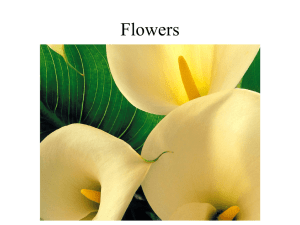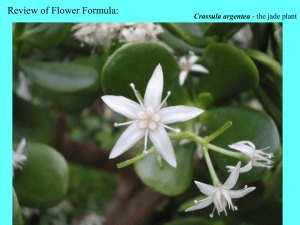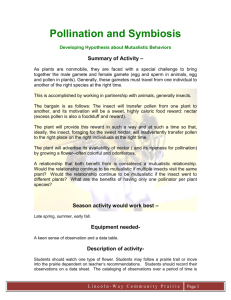The genus Psittacanthus
advertisement
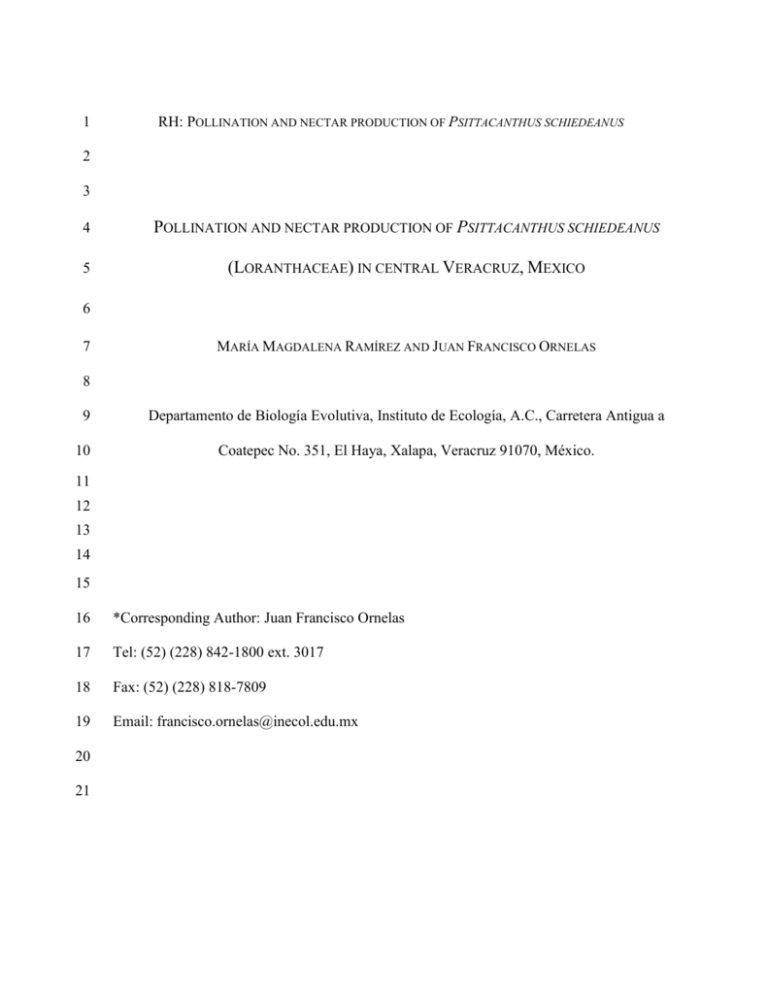
1 RH: POLLINATION AND NECTAR PRODUCTION OF PSITTACANTHUS SCHIEDEANUS 2 3 4 POLLINATION AND NECTAR PRODUCTION OF PSITTACANTHUS SCHIEDEANUS 5 (LORANTHACEAE) IN CENTRAL VERACRUZ, MEXICO 6 7 MARÍA MAGDALENA RAMÍREZ AND JUAN FRANCISCO ORNELAS 8 9 Departamento de Biología Evolutiva, Instituto de Ecología, A.C., Carretera Antigua a 10 Coatepec No. 351, El Haya, Xalapa, Veracruz 91070, México. 11 12 13 14 15 16 *Corresponding Author: Juan Francisco Ornelas 17 Tel: (52) (228) 842-1800 ext. 3017 18 Fax: (52) (228) 818-7809 19 Email: francisco.ornelas@inecol.edu.mx 20 21 MARÍA MAGDALENA RAMÍREZ AND JUAN FRANCISCO ORNELAS 22 Abstract: We assessed nectar production patterns, the breeding system, and overall pollinator 23 dependence of Psittacanthus schiedeanus (Schlechtendal & Chamisso) G. Don (Loranthaceae), a 24 mistletoe species that blooms in the late summer of the eastern cloud forests of Mexico and 25 whose flowers are mainly visited by hummingbirds. Despite differences in nectar production 26 rates over the lifespan of a flower, the daily nectar secretion of 3.6-7.2 mg sugar/flower/day was 27 high compared to other hummingbird-adapted plant species. Hand-pollination experiments 28 showed that this plant is self-compatible, with only a slight advantage of cross- (xenogamous) 29 and geitonogamous hand-pollinated flowers over autonomous hand-pollinated flowers. Hence, 30 the high production of nectar by P. schiedeanus flowers represents an important ecosystem 31 resource that may mediate interactions with a wide variety of floral visitors. Although P. 32 schiedeanus set selfed fruits autonomously, this plant requires hummingbirds to achieve its full 33 reproductive potential. 34 Key words: hummingbirds, Loranthaceae, Mexico, mistletoes, nectar production, pollination, 35 Psittacanthus. 36 37 Resumen: Determinamos la importancia de los patrones de producción de néctar, el sistema 38 reproductivo, y la dependencia general de un polinizador de Psittacanthus schiedeanus 39 (Schlechtendal & Chamisso) G. Don (Loranthaceae), una especie de muérdago que florece a 40 finales del verano de los bosques de niebla en el este de México cuyas flores son visitadas 41 principalmente por colibríes. A pesar de las diferencias en las tasas de producción de néctar a lo 42 largo de la vida de una flor, la secreción diaria de néctar de 3.6-7.2 mg azúcar/flor/día fue alta 43 comparada con otras especies de plantas adaptadas a colibríes. Los experimentos de polinización 2 POLLINATION AND NECTAR PRODUCTION OF PSITTACANTHUS SCHIEDEANUS 44 manual mostraron que esta planta es autocompatible, con solo una ligera ventaja por flores 45 manualmente cruzadas con flores de la misma planta (geitonogamia) o de una diferente 46 (xenogamia). Entonces, la producción alta de néctar por flores de P. schiedeanus representa un 47 recurso importante en el ecosistema que puede mediar interacciones con una gran variedad de 48 visitants florales. Aunque P. schiedeanus forma frutos por autogamia, esta planta requiere a los 49 colibríes para lograr su potencial reproductivo máximo. 50 Palabras clave: colibríes, Loranthaceae, México, muérdagos, polinización, producción de 51 néctar, Psittacanthus. 52 3 MARÍA MAGDALENA RAMÍREZ AND JUAN FRANCISCO ORNELAS 53 The genus Psittacanthus (Loranthaceae) is a New World aerial hemiparasite distributed from 54 Mexico to Argentina on a wide range of angiosperm and gymnosperm hosts (Kuijt, 2009). In 55 contrast to other mistletoes, Psittacanthus is distinguished by its large and conspicuous-red, 56 yellow, or orange flowers and bulky haustorial connections to the host trees, and by large fruits 57 which lack endosperm (Cházaro and Oliva, 1988; Kuijt, 2009). In his recent monographic 58 treatment of the genus, Kuijt (2009) considered 119 species in the genus, 51 of which are newly 59 described in his monograph. In his monograph, Kuijt (2009) recognized 11 species of 60 Psittacanthus for Mexico: P. angustifolius Kuijt, P. auriculatus (Oliver) Eichler in Martius, P. 61 breedlovei Kuijt, P. calyculatus (DC.) G. Don, P. macrantherus Eichler in Martius, P. mayanus 62 Standley & Steyermark, P. palmeri (S. Watson) Barlow & Wiens, P. ramiflorus (DC.) G. Don, 63 P. rhynchanthus (Bentham) Kuijt, P. schiedeanus (Schlechtendal & Chamisso) G. Don, and P. 64 sonorae (S. Watson) Kuijt. Although Psittacanthus is distributed throughout Mexico (Cházaro 65 and Oliva, 1988; Vázquez-Collazo and Geils, 2002), it is most common in the central and 66 southern regions ranging from sea level to 3,300 m. Parrot-flower mistletoes of the genus 67 Psittacanthus are considered to be the most damaging pathogens to attack commercially 68 important coniferous and other hardwood timber stands throughout Mexico (Vázquez-Collazo 69 and Geils, 2002). More than 50 genera of angiosperms and conifers have been reported as hosts 70 of Psittacanthus in Mexico, and several non-native plant genera (Vázquez-Collazo and Geils, 71 2002). The most common Psittacanthus species on conifers (Pinus and Abies) are P. 72 angustifolius and P. macrantherus (Kuijt, 1987, 2009; Mathiasen et al., 2007). In arid 73 environments and lowland, tropical deciduous forests, P. sonorae (Sonora and Baja California), 74 P. rhynchanthus (Balsas drainage), and P. palmeri (subtropical Central Plateau) parasitize almost 4 POLLINATION AND NECTAR PRODUCTION OF PSITTACANTHUS SCHIEDEANUS 75 exclusively Bursera species, and P. auriculatus (Tehuacán-Cuicatlán arid region) and P. 76 breedlovei (Chiapan Central Depression) are most commonly found on Acacia species (Kuijt, 77 2009). However, most Psittacanthus species often use more than one species of host. Despite 78 their negative economic impact, parrot-flower mistletoes are ecologically important in forest 79 ecosystems as they provide food, cover and nesting sites for a variety of birds, mammals and 80 insects (reviewed in Watson, 2001; Mathiasen et al., 2008). 81 Although mistletoe plants are parasites of trees, most are not damaging pathogens and do not 82 impact economically valuable crops and forest products but actually play key roles in forest 83 ecosystems associated with these parasitic flowering plants (reviewed in Watson, 2001; 84 Mathiasen et al., 2008). Coevolutionary relationships with birds (involving pollination and seed 85 dispersal) have fueled several adaptive radiations, thus producing one of the most diverse and 86 fascinating life forms on our planet. The coevolution of mistletoes with their avian vectors has 87 resulted in elaborate seed dispersal mechanisms and in attractive and nutritious fruits that 88 provide valuable food for many bird species throughout the world. Approximately 90 bird 89 species from 10 families are considered mistletoe fruit specialists, exhibiting a range of 90 behavioral and morphological adaptations to their narrow diet (Mathiasen et al., 2008 and 91 references therein). Elaborate pollination mechanisms involving birds have also evolved in some 92 of Loranthaceae species (e.g., Ladley and Kelly, 1995; Ladley et al., 1997). Many tropical and 93 subtropical mistletoes in Loranthaceae have large, colorful flowers borne in groups that produce 94 large amounts of sugar-rich nectar that attract avian pollinators. However, the basic reproductive 95 biology of most Neotropical Loranthaceae, and specifically Psittacanthus species, has not been 96 described. In Tristerix corymbosus, Aizen (2005) reported that hummingbird cross-pollination 5 MARÍA MAGDALENA RAMÍREZ AND JUAN FRANCISCO ORNELAS 97 had a slight advantage with respect to self hand-pollination in a population near Bariloche, 98 Argentina. The only detailed study of hummingbird pollination in Psittacanthus has been 99 recently accounted for P. calyculatus in Tlaxcala, Mexico (Azpeitia and Lara, 2006). They found 100 that anthesis in the species is initiated by anther dehiscence, and stigma receptivity followed only 101 24 h later. The flowering period lasts from July to November in the studied area, roughly 102 corresponding to the local mild and humid period. As in T. corymbosus, Aspeitia and Lara 103 (2006) found that P. calyculatus is predominantly an outbreeding plant, even though self- 104 pollination can also be effective. 105 Here we report the results of a breeding-system study to assess the overall dependence of P. 106 schiedeanus on hummingbirds for pollination and sexual reproduction. If pollinator services by 107 hummingbirds are effective and predictable, we expect an obligate dependence on hummingbirds 108 for reproduction, and the existence of a mechanism of reproductive assurance such as facultative, 109 autonomous self-pollination. In addition to testing for autogamous seed production and self- 110 compatibility, we also estimated self- and cross-pollinated flowers to assess the role of 111 outbreeding in P. schiedeanus, and nectar production patterns are described. 112 113 Materials and methods 114 115 Study system. Psittacanthus schiedeanus (Schlechtendal & Chamisso) G. Don, parrot-flower 116 mistletoe, is a shrubby (up to 3 m in height) hemiparasite distributed along the eastern rim of the 117 Sierra Madre Oriental between 1000 to 1800 m above sea level in Mexico to Panama. It 118 parasitizes tall trees in evergreen montane forests (Burger and Kuijt, 1983; Cházaro and Oliva, 6 POLLINATION AND NECTAR PRODUCTION OF PSITTACANTHUS SCHIEDEANUS 119 1988; López de Buen et al., 2002; Kuijt, 2009). Throughout its geographic range, it parasitizes 120 branches of more than 20 native and introduced host tree species (Cházaro and Oliva, 1988; 121 López de Buen and Ornelas, 1999). In central Veracruz, the most severe infections occur on 122 Liquidambar styraciflua var. mexicana (Oested.) (=macrophylla) (Altingiaceae) (López de Buen 123 and Ornelas, 1999; López de Buen et al., 2002). Reproductive plants with terminal and 124 secondary inflorescences can produce several hundred flower buds that differentiate and develop 125 during June and July. The floral buds (7.5-8.5 cm long) are more or less straight, slender, slightly 126 widening below tip. Long-pedicelate (10-30 mm long, n = 360, J.F. Ornelas, unpublished data) 127 flowers are arranged in 3.5 pairs of triads with peduncles 1-2 cm long. Peduncle and pedicels are 128 bright orange-red to yellow when exposed, especially in fruit (Kuijt, 2009). The flowers of P. 129 schiedeanus are actinomorphic and hexamerous (figure 1). Flowers last open c. 6 d in the study 130 area. As senesces the orange-yellow flower, or parts of it, turn red. When the flower opens to 131 near the base, the six petals strongly curl around and the filament holding out the anthers (34 mm 132 long, n = 341, J.F. Ornelas, unpublished data) in all directions inserted low on the petals. Flowers 133 open to different degrees, and filament length and level of filament implantation may be related 134 to pollination mode (figure 1). The narrow petals diverge greatly during anthesis, and no 135 discernable floral tube (8 mm long, n = 338, J.F. Ornelas, unpublished data) is then present. The 136 filaments are extremely long (71 mm long, n = 341, J.F. Ornelas, unpublished data), and are 137 similarly spread out during flowering. Several to many adjacent flowers in an inflorescence open 138 simultaneously (Kuijt, 2009). The most common pattern in the flower color is for the proximal 139 part of the filamentous petals to be bright orange (often brilliantly so) and the tips to be bright 140 yellow. The brilliant hues of the hermaphroditic flowers suggest that birds, especially 7 MARÍA MAGDALENA RAMÍREZ AND JUAN FRANCISCO ORNELAS 141 hummingbirds are the primary pollinators. Several hummingbird species (Campylopterus 142 curvipennis, Amazilia beryllina, A. cyanocephala, Lampornis amethystinus, Lamprolaima rhami, 143 Atthis heloisa), flowerpiercers (Diglossa baritula), butterflies, and bees have been observed 144 visiting flowers of P. schiedeanus in the study region (López de Buen and Ornelas, 2002; J. F. 145 Ornelas and L. Jiménez, unpublished data). Flowers mature into 13.8 9.5 mm, purplish-black fleshy, lipid-rich fruits containing one seed 146 147 which weight on average 335 mg (López de Buen and Ornelas, 2001). Fruit ripening occurs 148 asynchronously from November to April. Fruits are consumed and dispersed by a variety of 149 birds, the most important being Bombycilla cedrorum, Ptilogonys cinereus, and Myiozetetes 150 similis (López de Buen and Ornelas, 1999, 2001, 2002; Ramírez and Ornelas, 2009). 151 152 Study area. The study was conducted in central Veracruz, Mexico during the flowering seasons 153 of July-August 2003 and 2004, in two cloud forest remnants located near the city of Xalapa (La 154 Pitaya, Coatepec, 19°30´N, 96°57´W, at 1381 m above sea level; Rancho Viejo, San Andrés 155 Tlalnelhuayocan, 19°35´N, 96°01´W, at 1461 m above sea level). The region is characterized by 156 frequent and prolonged immersion within orographic clouds. Climate is mild and humid 157 throughout the year with a dry-cold season from November to March. The most common trees 158 species in the fragments are Liquidambar styraciflua var. mexicana, Quercus germana, Q. 159 leiophylla (Fagaceae), Platanus mexicana (Platanaceae), and Acacia pennatula (Leguminosae) 160 (López de Buen and Ornelas, 1999). 161 8 POLLINATION AND NECTAR PRODUCTION OF PSITTACANTHUS SCHIEDEANUS 162 Natural patterns of nectar production. The amount of nectar secreted by a flower may not be 163 clearly revealed when natural patterns of nectar production are measured, particularly among 164 species that positively respond to nectar extraction by their pollinators (Ordano and Ornelas, 165 2004). We quantified nectar production to determine whether flowers reward pollinators equally 166 over time and when the pollinators sought out such resources. Inflorescences of 8 mistletoes 167 plants growing on A. pennatula were bagged in July-August 2003 with bridal netting before bud 168 opening. Nectar was extracted the following day without removing the flowers from the plant 169 (non-destructive method). Nectar production was measured repeatedly throughout the life of 170 individual flowers at 24-h intervals during six days to minimize the effects of evaporation in the 171 quantification of nectar production. Nectar volume was measured using graduated micropipettes 172 (10 L) and a ruler. Sugar concentration (percentage sucrose) was measured with a pocket 173 refractometer (American Optical 10431, Buffalo, New York, USA; range of concentration 0◦–50◦ 174 BRIX scale) and the amount of sugar produced was expressed as milligrams of sugar after 175 Bolten et al. (1979) and Kearns and Inouye (1993). Two hundred flowers were examined. 176 In a different group of plants, we measured the nectar for which buds of selected inflorescences 177 were excluded from floral visitors to let nectar accumulate. The accumulated nectar was 178 extracted the following day after the exclusion at 0800. The one-day sampled flowers were 179 removed from the plant after nectar measurements (destructive-method) and the same procedure 180 was repeated on groups of flowers in which nectar was let to accumulate 2, 3, 4 and 5 days. 181 Nectar production was measured as described above. 182 9 MARÍA MAGDALENA RAMÍREZ AND JUAN FRANCISCO ORNELAS 183 Pollination experiments. To evaluate the relative importance of pollinators, the following 184 manual-pollination experiments were performed. In mid-August 2004, we selected flowering 185 branches of 8 reachable mistletoe plants growing on A. pennatula and recently opened flowers 186 were individually tagged and assigned per plant the following pollination treatments. To test for 187 within-flower, autonomous self-pollination and autogamous fruit set, we bagged the flower by 188 enclosing the flowering branch in a pollination bag made of 1-mm tul mesh (Treatment 1: 189 autogamy, n = 77 flowers). To test for self-compatibility, we hand-pollinated flowers of a given 190 flowering branch by brushing anthers from other flower of the same individual and excluded 191 pollinators by enclosing the flowering branch as described (Treatment 2: geitonogamy, n = 85 192 flowers). To test for cross-compatibility, we hand-pollinated flowers of a given flowering branch 193 with pollen from other individuals and excluded pollinators by enclosing the flowering branch as 194 described (Treatment 3: xenogamy, n = 93 flowers). Finally, we assessed natural pollination and 195 fruit set from a different group of flowers that remained open to pollinators (Treatment 4: open 196 pollination, n = 81 flowers). Hand-pollination (Treatments 2 and 3) was applied once on 3-d old 197 flowers when stigma receptivity is higher. Two months until fruit maturation we counted the 198 number of fruits per pollination treatment, measured with a calliper and weighted (0.001 g). 199 200 Statistical analyses. We used repeated-measures ANOVA to analyze plant differences regarding 201 nectar production (volume and amount of sugar) over each flower’s lifespan. The model includes 202 the effects of days (flower age) as repeated factors (i.e. within-subject factors) and the effects of 203 plants as between-subject factor. To evaluate the effects of flower age (day treatment) on 204 accumulated nectar, we used nested analyses of variance (ANOVAs) with type III sum of 10 POLLINATION AND NECTAR PRODUCTION OF PSITTACANTHUS SCHIEDEANUS 205 squares on nectar volume (microliters) and sugar production (mass of sugar in milligrams). 206 Nectar volume and total sugar produced here were intercorrelated response variables (volume vs. 207 sugar, r = 0.32, n = 202, P = 0.0001). Therefore, we first performed nested multivariate 208 ANOVAs (MANOVA) incorporating these response variables. In the model, flower age was a 209 fixed factor and plant factor was nested within flower age (day treatment). Using a MANOVA 210 followed by univariate ANOVAs as described above, will reduce the probability of inflating the 211 type I error rate. Nectar volume and mass of sugar data were log (x+1) transformed before 212 statistical analyses to achieve normality, but untransformed data (mean ± standard error) are 213 reported in figures. Pollination treatment and fruit production (fruit set) were tested with a G-test 214 of independence with Yates’ continuity correction. We used a Fisher’s exact test to test whether 215 fruit production differed between pollination treatments (flowers excluded to pollinators, 216 exposed to natural pollination, geitonogamy and xenogamy). All statistical analyses were run 217 using StatView and SuperANOVA (Abacus Concepts, Inc.). 218 219 Results 220 Nectar replenishment rates among flowers decreased over their lifespan (repeated-measures 221 ANOVA; flower age effect; nectar volume, F5,1340 = 1394.45, P = 0.0001; sugar production, 222 F5,1325 = 1044.03, P = 0.0001). Flowers subjected to daily repeated nectar removal replenished 223 about 2 times more nectar per day on day 1, 2 and 3 than they did from day 4 on (figure 2a). 224 Sugar production followed the same pattern over time described for total nectar volume (figure 225 2b). Patterns of variation were also affected by plant (nectar volume, F7,1340 = 33.98, P = 0.0001; 226 sugar production, F7,1325 = 19.81, P = 0.0001), and the plant × flower age interactions (nectar 11 MARÍA MAGDALENA RAMÍREZ AND JUAN FRANCISCO ORNELAS 227 volume, F35,1340 = 14.69, P = 0.0001; sugar production, F35,1325 = 11.27, P = 0.0001) were also 228 significant. 229 Flower age affected subsequent nectar production negatively in P. schiedeanus. A MANOVA 230 showed that flower age (day treatment) significantly influenced total nectar production for both 231 dependent variable (volume and amount of sugar, Wilks’ = 0.542, F10,412 = 14.73, P = 0.0001). 232 Plant individuals (nested within day treatments) were significantly heterogeneous for the two 233 dependent variables (Wilks’ = 0.546, F52,412 = 2.79, P = 0.0001). Because the MANOVA was 234 significant, we then followed with univariate ANOVAs. Daily nectar accumulation varied 235 significantly over time, decreasing with flower age (one-way ANOVA, F5,207 = 30.74, P = 236 0.0001). Undisturbed flowers accumulate c. 17 microliters on day 1 after 24 h of accumulation 237 but decreases as they aged from day 2 on (figure 2a) likely due to evaporation and/or reasorption. 238 Daily sugar production also varied significantly over time (one-way ANOVA, F5,207 = 24.05, P = 239 0.0001), decreasing with flower age. An undisturbed flower accumulates c. 2 milligrams per day 240 on day 1 and 2 after 24-48 h of accumulation, but then steeply decreases from day 3 on (figure 241 2b). 242 When flowers that experienced repeated removals are visually compared with those 243 undisturbed flowers that accumulated nectar over time, the total amount of fluid and sugar 244 secreted was markedly different between nectar treatments (Figure 2); undisturbed flowers 245 secreted about half the amount of fluid or sugar secreted by flowers subjected to repeated nectar 246 removal (figure 2). 247 248 Flowers from all pollination treatments set fruit. Outcrossed (xenogamy), hand-pollinated flowers set fruits as well as flowers exposed to geitonogamous crosses, natural pollination 12 POLLINATION AND NECTAR PRODUCTION OF PSITTACANTHUS SCHIEDEANUS 249 (control), and flowers excluded from pollination (autogamy) (table 1). However, fruit production 250 was not independent of pollination treatment (G = 11.36, df = 3, P < 0.01). Fruit set (in relation 251 to flower number) was somewhat higher in geitonogamous hand-pollinated flowers (37.6%) than 252 xenogamous hand-pollinated flowers (35.5%), flowers open to natural pollination (22.2%) and 253 excluded, autogamous flowers (18.2%). Fruit set (in relation to flower number) was significantly 254 higher (P = 0.044 in a Fisher’s exact test) in geitonogamous flowers than in autogamous flowers; 255 fruit set in xenogamous flowers differed marginally from autogamous flowers (P = 0.06). There 256 were no significant differences among fruit set in the remaining comparisons (P > 0.1 in Fisher’s 257 exact tests; see also table 1). Because hand self-pollinated flowers set almost as many as cross- 258 pollinated (P = 0.88 in a Fisher’s exact test), we consider P. schiedeanus to be fully self- 259 compatible. However, open- and hand-pollinated flowers set more fruits than autonomous self- 260 pollinated flowers. Thus, although P. schiedeanus set selfed fruits autonomously, this plant 261 requires hummingbirds to achieve its full reproductive potential. Lastly, no significant 262 differences in fruit size were observed among treatments (P > 0.1, table 1). 263 264 Discussion 265 We used nectar production after repeated removal as a nectar sampling technique to investigate 266 maximum nectar output to floral visitors across the flower’s lifespan (see also Hernández- 267 Conrique et al., 2007). By repeatedly removing nectar, we may have stimulated replenishment of 268 the fluid and therefore natural secretion patterns may have been obscured. However, nectar 269 accumulation data avoid this problem but underestimates the capacity of the plants to respond to 270 repeated nectar removal by floral visitors (Ordano and Ornelas, 2004). By emptying all nectar 13 MARÍA MAGDALENA RAMÍREZ AND JUAN FRANCISCO ORNELAS 271 from the same set of flowers at daily intervals, we minimized the effects of evaporation observed 272 among flowers left to accumulate nectar, so it is unlikely that variation in nectar replenishment 273 rates is due to microclimate differences over the flower’s lifespan. The result of decreased nectar 274 accumulation over time ties in well with the result that hummingbird-adapted flowers do usually 275 increased total nectar production when drained repeatedly. In P. schiedeanus, the magnitude of 276 the response to the removal effect can be explained in part by the large number of floral visitors. 277 Hence, the high production of nectar by P. schiedeanus flowers (and the number of flowers 278 produced per plant) represents an important ecosystem resource that may mediate interactions 279 with a wide variety of plant visitors, depending on seasonal and spatial availability. The sugar 280 totals (3.6-7.2 mg sugar per flower per day) are high compared to values of other hummingbird- 281 visited species (reviewed in Ornelas et al., 2007). For hummingbirds, P. schiedeanus represents a 282 rich resource compared to other hummingbird-pollinated flowers of the cloud forests in the 283 region (e.g., Lara and Ornelas, 2003; Ornelas et al., 2004), other late summer flowers in this 284 region (Lara and Ornelas, 2002), flowers from other Psittacanthus species (Azpeitia and Lara, 285 2006), or from other hummingbird-adapted species (Hernández-Conrique et al., 2007; Lara and 286 Ornelas, 2008). Although Neotropical mistletoe flowers are highly variable in terms of nectar 287 production, values for P. schiedeanus are high to median for Neotropical mistletoe flowers 288 (Cruden et al., 1983; Opler, 1983; Stiles and Freeman, 1993; Tadey and Aizen, 2001; Ornelas et 289 al., 2007). 290 Autonomous, within-flower self-pollination has been proposed as a feature characterizing the 291 breeding system of many Loranthaceae (Aizen, 2005; Azpeitia and Lara, 2006). Despite self- 292 compatibility, P. schiedeanus exhibits a limited capacity for self-pollination, about one third of 14 POLLINATION AND NECTAR PRODUCTION OF PSITTACANTHUS SCHIEDEANUS 293 full seed set. Therefore, this plant requires the service of its hummingbird pollinators to achieve 294 full reproductive success. Although spatial separation of androecium and gynoecium is 295 characteristic of many bird-pollinated members of Loranthaceae (e.g., Ladley et al., 1997), there 296 is no particular mechanism promoting autonomous self-pollination in P. schiedeanus. The fitness 297 consequences of self-fertilization are largely determined by how self-pollination occurs in P. 298 schiedeanus. Within-flower self-pollination (autogamy) may be advantageous, since it can 299 provide reproductive assurance under conditions of pollinator scarcity without much seed or 300 pollen discounting (see also Aizen, 2005). In contrast, between-flower self-pollination 301 (geitonogamy) provides no reproductive assurance and can cause severe seed and pollen 302 discounting. Although geitonogamy is functionally cross-pollination involving a pollinating 303 agent, genetically it is similar to autogamy since the pollen grains come from the same plant. 304 Further observations on how pollination occurs in P. schiedeanus are needed to determine how 305 common geitonogamy is under natural conditions, and which floral visitors promote 306 geitonogamous crosses. 307 308 Acknowledgements 309 We thank Olivia Cevallos and Irma Ruán for help in fieldwork. Comments by José Guadalupe 310 García Franco greatly improved an earlier version of this paper. We were supported by a 311 research grant (2005-01) from the fellowship graduate program of the Instituto de Ecología, A.C. 312 and a doctoral scholarship (171228) granted by the Consejo Nacional de Ciencia y Tecnología 313 (CONACyT-México) to M. M. Ramírez, and research funds (902- 12-563) from the 314 Departamento de Biología Evolutiva, Instituto de Ecología, A.C. to J. F. Ornelas. This work 15 MARÍA MAGDALENA RAMÍREZ AND JUAN FRANCISCO ORNELAS 315 constitutes partial fulfillment of M.M.R.’s doctorate in Ecología y Manejo de Recursos Naturales 316 at the Instituto de Ecología, A.C. 317 318 Literature cited 319 Aizen M.A. 2005. Breeding system of Tristerix corymbosus (Loranthaceae), a winter-flowering 320 321 mistletoe from the southern Andes. Australian Journal of Botany 53:357–361. Azpeitia F. and Lara C. 2006. Reproductive biology and pollination of the parasitic plant 322 Psittacanthus calyculatus (Loranthaceae) in Central Mexico. Journal of the Torrey 323 Botanical Society 133:429–438. 324 Bolten A.B., Feinsinger P., Baker H.G. and Baker I. 1979. On the calculation of sugar 325 326 concentration in flower nectar. Oecologia 41:301-304. Burger W. and Kuijt J. 1983. Loranthaceae sensu lato. In Burger W. Ed. Flora Costarricensis, 327 pp. 29–79, Feldiana Botany, New Series 13, Publication 1350, Field Museum of Natural 328 History, Chicago. 329 Cházaro M. and Oliva R. 1988. Loranthaceae del centro de Veracruz y zona limítrofe de Puebla, 330 331 IV. Cactáceas y Suculentas Mexicanas 33:42–48. Cruden R.W., Hermann S.M. and Peterson S. 1983. Patterns of nectar production and plant 332 animal coevolution. In Bentley B. and Elias T. Eds. The biology of nectaries, pp. 126– 333 152, Columbia University Press, New York. 334 Hernández-Conrique D., Ornelas J.F., García-Franco J.G. and Vargas C.F. 2007. Nectar 335 production of Calliandra longipedicellata (Fabaceae: Mimosoideae), an endemic Mexican 336 shrub with multiple potential pollinators. Biotropica 39:459–467. 16 POLLINATION AND NECTAR PRODUCTION OF PSITTACANTHUS SCHIEDEANUS 337 338 339 340 341 342 Kearns C.A. and Inouye D.W. 1993. Techniques for pollination biologists. University Press of Colorado, Niwot, Colorado. Kuijt J. 1987. Novelties in Mesoamerican mistletoes (Loranthaceae and Viscaceae). Annals of the Missouri Botanical Garden 74:511–532. Kuijt J. 2009. Monograph of Psittacanthus (Loranthaceae). Systematic Botany Monographs Vol. 86. American Society of Plant Taxonomists, Ann Harbor. 343 Ladley J.J. and Kelly D. 1995. Explosive New Zealand mistletoe. Nature 378: 766. 344 Ladley J.J., Kelly D. and Robertson A.W. 1997. Explosive flowering, nectar production, 345 breeding systems and pollinators of New Zealand mistletoes (Loranthaceae). New 346 Zealand Journal of Botany 35:345–360. 347 Lara C. and Ornelas J.F. 2002. Flower mites and nectar production in six hummingbird- 348 pollinated plants with contrasting flower longevities. Canadian Journal of Botany 349 80:1216–1229. 350 Lara C. and Ornelas J.F. 2003. Hummingbirds as vectors of fungal spores in Moussonia 351 deppeana (Gesneriaceae): Taking advantage from a mutualism? American Journal of 352 Botany 90:260–267. 353 Lara C. and Ornelas J.F. 2008. Pollination ecology of Penstemon roseus (Plantaginaceae), an 354 endemic perennial shifted toward hummingbird specialization? Plant Systematics and 355 Evolution 271:223–237. 356 López de Buen L. and Ornelas J.F. 1999. Frugivorous birds, host selection and the mistletoe 357 Psittacanthus schiedeanus, in central Veracruz, Mexico. Journal of Tropical Ecology 358 15:329–340. 17 MARÍA MAGDALENA RAMÍREZ AND JUAN FRANCISCO ORNELAS 359 López de Buen L. and Ornelas J.F. 2001. Seed dispersal of the mistletoe Psittacanthus 360 schiedeanus by birds in central Veracruz, Mexico. Biotropica 33:487–494. 361 López de Buen L. and Ornelas J.F. 2002. Host compatibility of the cloud forest mistletoe 362 Psittacanthus schiedeanus (Loranthaceae) in central Veracruz, Mexico. American 363 Journal of Botany 89:95–102. 364 López de Buen L., Ornelas J.F. and García-Franco J.G. 2002. Mistletoe infection of trees located 365 at fragmented forest edges in the cloud forests of central Veracruz, Mexico. Forest 366 Ecology and Management 164:293–302. 367 Mathiasen R.L., Nickrent D.L., Shaw D.C. and Watson D.M. 2008. Mistletoes: Pathology, 368 369 systematics, ecology, and management. Plant Disease 92:988–1006. Opler P.A. 1983. Nectar production in a tropical ecosystem. In Bentley B. and Elias T. Eds. The 370 371 Biology of Nectaries, pp. 30–79, Columbia University Press, New York. Ordano M. and Ornelas J.F. 2004. Generous-like flowers: nectar production in two epiphytic 372 bromeliads and a meta-analysis of removal effects. Oecologia 140:495-505. 373 Ornelas J.F., González C., Jiménez L., Lara C. and Martínez A.J. 2004. Reproductive ecology of 374 distylous Palicourea padifolia (Rubiaceae) in a tropical montane cloud forest. II. Attracting 375 and rewarding mutualistic and antagonistic visitors. American Journal of Botany 91:1061– 376 1069. 377 Ornelas J.F., Ordano M., de-Nova A., Quintero M.E. and Garland T. 2007. Phylogenetic analysis 378 of interspecific variation in nectar of hummingbird-visited plants. Journal of Evolutionary 379 Biology 20:1904–1917, 18 POLLINATION AND NECTAR PRODUCTION OF PSITTACANTHUS SCHIEDEANUS 380 Ramírez M.M. and Ornelas J.F. 2009. Germination of Psittacanthus schiedeanus (mistletoe) 381 seeds after passage through the gut of Cedar Waxwings and Grey Silky-Flycatchers. 382 Journal of the Torrey Botanical Society 136:322–331. 383 384 385 386 387 Stiles F.G. and Freeman C.E. 1993. Patterns in floral nectar characteristics of some bird-visited plant species from Costa Rica. Biotropica 25:191–205. Tadey M. and Aizen M.A. 2001. Why do flowers of a hummingbird-pollinated mistletoe face down? Functional Ecology 15:782–790. Vázquez-Collazo T. and Geils B.W. 2002. Psittacanthus in Mexico. In: Geils B.W., Cibrián 388 Tovar J. and Moody B. Eds. Mistletoes of North American Conifers, pp. 9–17, Gen. Tech. 389 Rep. RMRS-GTR-98. U.S. Department of Agriculture, Forest Service, Rocky Mountain 390 Research Station, Ogden. 391 392 Watson D.M. 2001. Mistletoe -–a keystone resource in forests and woodlands worldwide. Annual Review in Ecology and Systematics 32:219–49. 19 MARÍA MAGDALENA RAMÍREZ AND JUAN FRANCISCO ORNELAS 393 394 Figure legends 395 396 Figure 1. Typical inflorescence of Psittacanthus schiedeanus showing open flowers and floral 397 buds at various developmental stages. Note that the petals strongly curl around and the filament 398 holding out the anthers in all directions inserted low on the petals. Photo by Juan Francisco 399 Ornelas. 400 401 Figure 2. Cumulative nectar after repeated removals (open circles) and accumulated nectar over 402 time (closed circles) of Psittacanthus schiedeanus flowers. Data are means ± 1 SE. (a) Nectar 403 volume (in microliters), (b) sugar production (in milligrams). 404 20 405 406 Table 1. Fruit set (number of flowers / number of fruits) and fruit size in Psittacanthus schiedeanus for 407 flowers exposed to pollination treatments. Fruit size data are means ± 1 SE. 408 Pollination treatment 409 Number of Number of flowers fruits Fruit set Fruit Fruit Fruit width length weight (mm) (mm) (g) Autonomous self-pollination 77 14 0.18 9.19±0.2 13.73±0.3 0.75±0.04 Geitonogamous hand-pollination 85 32 0.38 9.36±0.1 13.70±0.2 0.71±0.03 Xenogamous hand-pollination 93 33 0.35 9.36±0.1 13.77±0.2 0.75±0.02 Open pollination 81 18 0.22 9.46±0.1 14.01±0.3 0.76±0.04 410 411 412 POLLINATION AND NECTAR PRODUCTION OF PSITTACANTHUS SCHIEDEANUS 413 23





